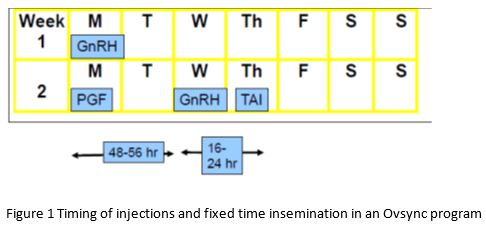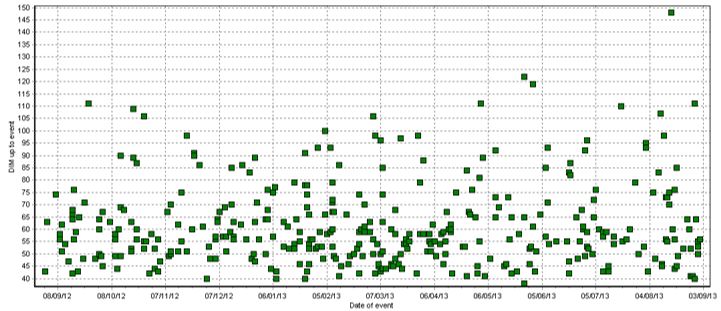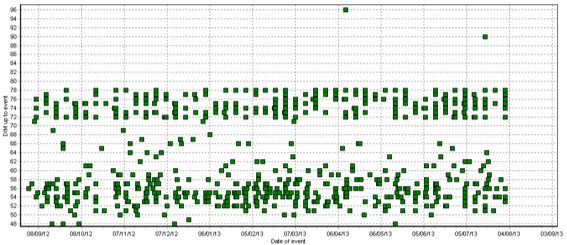



Optimising Synchronisation: Getting Them Pregnant
Synchronising cows for artificial insemination (AI) has been commonplace for around twenty years, but how do farms ensure only those cows that need synchronising are the subject of such programmes?Since 1995 and the development of the Ovsync protocol, synchronising dairy cows for AI has been widespread, although choosing which cows to treat, when and how remains a dilemma.
This was put forward by veterinarian John Cook of the European Board of Bovine Experts for the British Veterinary Association at the London Vet Shown in November, where he questioned the ethics behind synchronization compared with multiple rectal examinations.
Fifty Years of Development
In an article first appearing in the Veterinary Times, Mr Cook explained the work between 1956 and 1967 which largely established the mechanism of luteolysis and that the luteolytic substance originated from the uterus.
This was transported to the ovary via a local process involving an intimate relationship between the uterine vein and ovarian artery, writes Mr Cook.
But, it was not until 1979 that the world saw the first prostaglandin (PG) product (Lutalyse®, dinoprost trimethamine) licensed for use in cattle by the United States Department of Agriculture and become the first pharmacological agent used to manipulate reproduction in dairy cows.
The first systematic and structured use of these products was termed ‘targeted breeding’ where cows were injected on either a weekly or fortnightly basis and then either inseminated (AI) at observed heat or inseminated at a timed insemination at a fixed time after the injections were administered. The procedure could be further refined by veterinary palpation or later ultrasound examination of cows to identify those animals likely to have a corpus luteum (CL) and therefore thought more likely to respond to treatment.
The word synchronisation implies that two or more events are about to take place at the same moment in time and that the occurrence of one can be reliably predicted by the other which is not the case in protocols that rely solely on prostaglandin.
Prostaglandin merely destroys the CL and does not reliably result in ovulation in a time scale in which the cow can be inseminated and a reasonable outcome (chance of pregnancy) be expected, writes Mr Cook.
Results of inseminations to observed heats occurring after prostaglandin administration proved to be acceptable however the results of inseminations conducted ‘blind’ or ‘fixed’ time insemination were disappointing until it was realised that the timing of ovulation based on the timing of the prostaglandin injection was highly variable over an extended time period and was dependent upon the stage of follicular wave development of the cow at the time of injection and fixed time AI fell into disuse due to the poor results obtained.
The use of ultrasound and blood hormone assays led to the discovery and understanding of follicular waves in cattle and ultimately the development and publication of the Ovsync protocol in 1995 which has now become widely adopted globally within the dairy industry as a breeding tool to ensure timely insemination of cows.
The Ovsync protocol utilises a series of 3 injections (Figure 1) given at specific timings designed to cause a sequence of events that ultimately result in the ovulation of a fertile egg in a predictable time window so insemination can be timed such that both a viable egg and sperm are present in the reproductive tract of the cow. Insemination is synchronised to occur around the time when the cow is ovulating so the probability of a desirable outcome is greatly improved.
Figure 1
Ideally the first gonadotropin releasing hormone (GnRH) injection of the Ovsync protocol is designed to ovulate from the ovaries all responsive follicles present and set up a secondary CL enhancing the influence of progesterone on the cow allowing the next follicular wave, which will emerge 48-72 hours later to develop in an optimal progesterone environment. This follicular wave and the dominant follicle (DF) ensuing from it are then allowed to develop for a number of days so that the DF reaches a size optimal for ovulation and fertilisation.
A PG injection then causes removal of luteal tissue allowing the DF to fully mature before ovulation is initiated by the 2nd GnRH injection. All being well ovulation then occurs 24-32 hours after the 2nd GnRH treatment allowing insemination to be timed appropriately. The lack of heat behaviour and uterine tone in cows presented for Ovsync insemination is often noted but if all goes according to plan the DF should be ovulated prior to the production of sufficient oestrogens to cause oestrus behaviour and some of its associated physiological changes.
Knowledge of follicular waves and the differences between lactating cows and heifers also dictates that different protocols should be used in virgin heifers than cows as heifers are likely to have a bigger proportion of time when they will be unresponsive to Ovsync type protocols.
In terms of synchronisation and reproductive physiology it is probably best if heifers are actually considered as a separate species to lactating cows such are the differences! An example of a protocol the author has used with great success in heifers is show in Figure 2.
Ovsync offered dairy producers the first opportunity to adopt fixed time insemination as a viable management strategy. The next development in the synchronisation story was the understanding that conception rate could be improved if the Ovsync protocol (1st GnRH injection) could be commenced on a particular day of the cycle (day 4-12) and this led to the development of pre-synchronisation protocols.
Figure 2
Pre-synchronisation protocols generally involve one of two strategies, protocols that use prostaglandin to lyse CL’s and so promote oestrus expression in cows which can be inseminated if desired or protocols that cause ovulation of DF’s present on the ovary resulting in CL formation and a tendency to reduce the occurrence of heats which may otherwise have occurred and so reduce the opportunities to inseminate cows.
It is interesting to note that over enthusiastic use of protocols that promote ovulation at inappropriate times and particularly in herds with good heat detection and conception rates can actually result in a reduction in overall reproductive performance for the herd and an increase in days open.
Pre-synchronisation programs that promote ovulation would include what is known as G-6-G, G-5-G and Double Ovsync whilst programs that use sequential injections of prostaglandin promote destruction of CL’s and increase available heats. A further refinement to prostaglandin based pre-synchronisation programs includes varying the time interval between the final prostaglandin injection and the commencement of Ovsync to a 10, 11 or 12 day interval in an attempt to further enhance conception rates as Ovsync will commence in a tighter 4-9 day window at the start of a cycle.
The most common synchronisation protocol encountered globally is Ovsync, whilst the most common pre-synchronisation procedure is two injections of PG given 14 days apart with the 2nd injection occurring 14 days before the commencement of Ovsync.
Whilst other programs may claim better conception rates it should be realised that many of the studies on which claims may be based are carried out on pre-screened populations of cows which are likely to differ considerably in terms of their reproductive potential to the target animal in most dairy herds. The extra complexity of the programs and the record keeping involved also usually results in an increase in program non-compliance (cows which fail to get the correct treatment on the correct day) which obfuscates any advantages gained from using a more sophisticated program.
The questions then arise which cows should be synchronised and by which program?
In some large herds it has become common practice to breed all cows by timed AI to synchronisation programs for a variety of reasons. Firstly large herds may find it more convenient and cost effective to organise labour and work routines in a consistent manner so that certain tasks always occur on a certain day of the week allowing skilled staff to focus better on certain aspects of cow care at certain times and by doing so it may be that these herds generate health and welfare benefits for their cows in other management areas.
Secondly some herds are unable to detect heats in sufficient numbers and with sufficient accuracy to generate enough pregnancies to sustain viable production and so will turn to 100 per cent timed AI, however it is the authors opinion that if a herd is deemed so incapable of detecting heats it implies either major issues with cow health and heat expression or staff skill and training. A herd incapable of detecting behavioural changes in cows such as oestrus are unlikely to be to be able to detect more critical and subtle behavioural changes indicative of ill health.
Most herds then will then chose to operate a system combining detection of heat with synchronisation of selected cows or cows that reach a certain stage of lactation without receiving a first AI and again the question arises as to which cows to synchronise?
It is important point to realise that reproductive failure is a metabolic problem that occurs a considerable time prior to the cow presenting as a ‘problem’.
Metabolic damage to developing follicles in the cow’s ovary probably takes place some 60-90 days prior to the cow presenting as one of a variety of clinical syndromes and being categorised as one of either an anoestrus, cystic or repeat breeder cow.
In reality all of these presentations are likely to have the same underlying problem-follicular dysfunction due to metabolic damage sustained by follicles and oocytes developing in a poor internal metabolic environment which occurs either due to negative energy balance/fatty liver syndrome around the time of calving or bouts of acidosis which usually occur during lactation.
In herds where heat detection is adequate and effective the cows will split into two groups post calving. First we have a group of cows that transition metabolically stable and progress to cycle normally, express heat and end up pregnant by 150 days in milk (DIM). Importantly these cows have experienced their first ovulation post calving by 30 DIM implying that they returned to positive energy balance by around 14 DIM.
The first ovulation post calving is a clockwork like event that occurs without fail, 10-14 days after the cow returns to positive energy balance. In an ideal world we would of course like 100 per cent of our cows to achieve this but unfortunately in biology 100 per cent does not exist! The best performing herds achieve around 85 per cent of their cows in this category.
The first ovulation post calving is of course in most cows (80 per cent ) a silent event unaccompanied by heat so it is problematic to know which these cows are, however cows in this category are at high risk of being observed in heat and inseminated for the first time by 80 DIM. These cows then should not require synchronisation or other pharmacological intervention to become pregnant in a timely way and will generally be found to have a mean days open of 110-120 days.
The second group of cows in the herd are cows which transition relatively metabolically unstable, cycle abnormally and end up not becoming pregnant until after 150 DIM. These cows fail to ovulate for the first time until after 30 DIM.
In most reasonable situations these cows will be 15-25 per cent of the cows in the herd, they will fail to receive an insemination to natural heat by 80 DIM and will go on to have extended days open. These cows require help to get pregnant because they have metabolically damaged ovaries and are at high risk of being reproductive culls.
The reproductive failure in these cows is the result of a failure of management and as the keepers of these animals it is incumbent upon us to ensure that these cows have every opportunity to remain in the herd and become pregnant thus extending their productive lives. Synchronisation is the most effective way to achieve this and it is the author’s opinion that where heat detection systems are effective all cows not receiving a first insemination by 80 DIM should be submitted to a synchronisation protocol regardless of what structures are observed on the cow’s ovaries.
The datasets depicted in Figures 3 and 4 show the effect on timing of pregnancy of two differing management strategies and clearly shows the benefits of routinely submitting cows to Ovsync regardless of ultrasound findings. Herds in both data sets have effective heat detection systems in place.
Figure 3
In Figure 3 cows not inseminated to natural heats are submitted to veterinary ultrasound examination and cows are selected for treatment on a per cow basis. In Figure 4 cows not inseminated to natural heat are enrolled to an Ovsync program to ensure timed AI by 80 DIM.
Combining good heat detection with appropriate synchronisation of target cows provides a comprehensive system of sequential ‘pregnancy’ traps for cows to fall into as they progress through lactation giving every cow opportunities to become pregnant and stay in the herd.
Figure 4
Ethical Questions
Research has led the dairy industry to the point where effective synchronisation protocols are available to offer all cows an equal chance to become pregnant and remain in the herd and an epidemiological understanding of reproductive failure and its underlying causes allows us to accurately target which cows require synchronisation without the need for expensive and invasive interventions such as rectal examinations.
Society and the consumer may take a dim view of 100 per cent synchronisation strategies but is it really any worse or less desirable and less welfare friendly than the multiple, repetitive and often futile rectal examinations being performed over and over again on our dairy cows?








